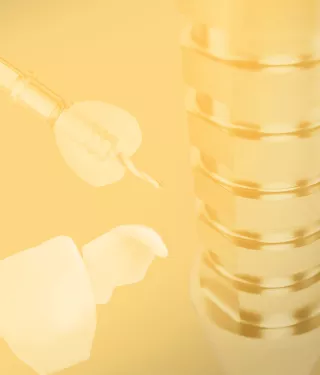
“The Intricacies of Immediate Implant Placement and Provisionalization” In conversation with Drs. Kyle Stanley and Brian Goodacre
A patient walks into your office with a non-restorable tooth. What is your workflow to improve the chances they can walk out of your office with an immediate implant placement and provisionalization? This was the scenario that led to a great conversation and webinar hosted by Drs. Kyle Stanley and Brian Goodacre. If you missed the webinar, the replay is now live — register to watch the presentation.
In the webinar “The Intricacies of Immediate Implant Placement and Provisionalization”, Drs. Stanley and Goodacre invite you to be a fly on the wall as they explore the finer details of immediate function.
- 1. Countering patient perceptions on healing time
- 2. Immediate placement and the surgeon-restorative doctor relationship
- 3. What about placing an implant in a previously infected site?
- 4. What about depth for anterior implants?
- 5. What if they have no buccal bone?
- 6. What about aftercare? What do you tell patients?
- 7. What’s your timeframe for final restorations?
- 8. What is your antibiotic regimen for implant surgery?
- 9. What about placing immediate implants in the maxillary molar region?
Countering patient perceptions on healing time
During the opening of the webinar, Dr. Stanley relays the sentiments of many patients as they pertain to dental implants: “Everything that is done in dentistry is usually done quickly, why not dental implants?” Dr. Stanley stated that reducing chair time was one of the first aspects that drew him to immediate placement and provisionalization. But, after realizing esthetically pleasing results and the preservation of more tissue architecture, he believes that immediate placement is more than just time saving. Dr. Goodacre expounded on this by stating that immediate implant placement and provisionalization simply makes sense — “You don’t have to develop the site; it’s already developed.”
Immediate placement and the surgeon-restorative doctor relationship
Even though Drs. Stanley and Goodacre perform both the surgical and restorative aspects, they do see how immediate placement can help the surgeon-restorative doctor relationship.
“You’re giving the restorative doctor a perfect emergence profile and it makes [the restoration process] so easy.” says Dr. Stanley.
And, with reduced chair time, there are also financial incentives to go with immediate placement.
What about depth for anterior implants?
Dr. Stanley says that his ideal supracrestal attachment would be between 3 to 5 mm, with 4 mm being optimal.
What about placing an implant in a previously infected site?
While he used to be very timid about placing implants in sites with a recent infection, Dr. Stanley states that he’s gotten “very aggressive.” He continues, “My thought is that if I can get in there and clean out all the granulation tissue, then I feel comfortable with that”. He says not cleaning out the infection before placing the implant is where clinicians often go wrong.
Dr. Goodacre observed that, if you’re replacing a single tooth, there’s likely a reason it’s coming out, and part of that reason is likely an infection.
What if they have no buccal bone?
In replying to the question of what to do in situations with no buccal bone, Dr. Stanley replied that he would graft in these instances. He went on to state that every immediate he places now gets bone and tissue grafts — “anterior, posterior — even if they have plenty of bone. It’s not that much work for myself and the patients, but the results I see are so much better. By thickening the tissue, you’re also protecting the bone.”
Dr. Stanley showed a slide of a NobelActive® 3.5 x13 mm implant placed at the anterior (10 position) with guided surgery. Dr. Stanley says he always takes a radiograph following the pilot osteotomy to ensure that everything is going according to plan. Dr. Stanley references Dr. Stephen Chen’s study1 where he found that the center of the implant should be lingual to the line connected from the buccal aspects of the adjacent teeth. In practice, Dr. Stanley states that this means he will usually place it at the lingual/palatal wall. In addition to being good quality connective tissue, taking tissue from the tuberosity is usually much less painful than taking connective tissue from the palate.
What about aftercare? What do you tell patients?
“Implants are very predictable, but they can fail.” says Dr. Stanley. He advises patients to chew on the side of the mouth opposite the implant for the first 6 weeks. He states that the problem with implants is they don’t relay pain, so patients may have difficulty realizing the damage they are doing to the implant site.
What’s your timeframe for final restorations?
Dr. Stanley revealed that he once was overly cautious about timing the placement of final restorations. But now he’s usually doing final restorations at four months for the upper jaw and three months for the lower jaw. Although, for many years, he was a 6-month-restoration kind of clinician.
What is your antibiotic regimen for implant surgery?
Dr. Stanley states that instead of doing antibiotics following implant placement, he’s now starting patients on antibiotic therapy prior to placement.
What about placing immediate implants in the maxillary molar region?
Both doctors agreed that it’s okay to place an immediate implant in the maxillary molar region, so long as good primary stability and an ideal implant position can be achieved. Dr. Stanley revealed he doesn’t perform many sinus lifts or bumps. He also says he doesn’t do provisionals on immediate placements, but he will do custom healing abutments, “which is like a really short provisional.”
References
1. Chen S T, Darby I B, Reynolds EC. A prospective clinical study of non-submerged immediate implants: clinical outcomes and esthetic results Clin Oral Implants Res. 2007 Oct;18(5):552-62. doi: 10.1111/j.1600-0501.2007.01388.x. https://pubmed.ncbi.nlm.nih.gov/17608739